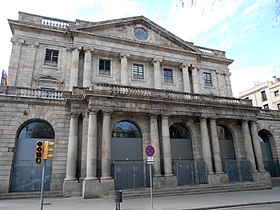| Llotja de Barcelona | |
|---|---|
 Palace of the Llotja de Mar | |
 | |
| General information | |
| Status | Monument |
| Type | Bien de Interés Cultural Patrimonio histórico español |
| Architectural style | Gothic and Neoclassical |
| Location | Sant Pere, Santa Caterina i la Ribera |
| Address | Passeig d'Isabel II, 1 |
| Town or city | |
| Country | |
| Coordinates | 41°22′56″N 2°10′57″E / 41.3822°N 2.1825°E |
| Construction started | 14th–15th century |
| Construction stopped | 1774–1802 |
| Owner | Cambra Oficial de Comerç, Indústria i Navegació de Barcelona |
| Design and construction | |
| Architect(s) | Pere Arvei and Joan Soler i Faneca |
| Known for | Cambra de Comerç de Barcelona, Reial Acadèmia Catalana de Belles Arts de Sant Jordi |
| Website | |
| http://www.casallotja.com/ | |
The Llotja de Barcelona or Llotja de Mar (Catalan for Loggia of Barcelona or Sea Loggia) is a building located on Passeig d'Isabel II, in the La Ribera neighbourhood of Barcelona. The current 18th-century neoclassical building is considered one of the finest neoclassical building in Barcelona. Hidden within its walls, is the core of the original medieval llotja known as the saló de Contractacions, one of the finest civil gothic buildings in the Mediterranean. Originally conceived to provide merchants with a place for commercial transactions, it has also been used as a wheat store, an entertainment space, as a weapon magazine, a military barracks and the seat of the Consulate of the Sea and the Royal Barcelona Board of Trade.[1] Today it houses the Cambra de Comerç and the Reial Acadèmia Catalana de Belles Arts de Sant Jordi.
- ^ Bernaus i Vidal & Caballé i Crivillés 2003, p. 781,782.